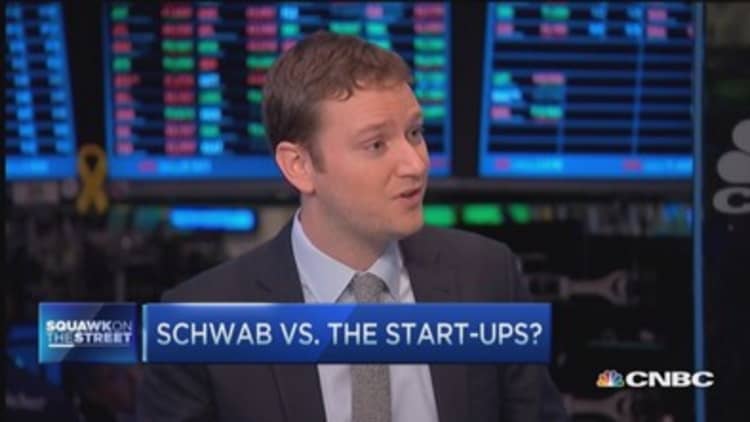When certified financial planner Sean Burgess began offering investment management services to his clients six months ago, he turned to an asset manager that some of his peers consider direct competition: a robo-advisor.
"No one comes close to their [low] cost," said Burgess, principal of Burgess Financial Planning. "I thought it was perfect for my business."
So-called robo-advisors are automated online investment advisory services that are gaining a foothold in the asset management industry. Along with providing automated algorithm-based portfolio management advice, some robo-advisors offer automatic portfolio rebalancing and tax-loss harvesting.
While the assets they hold—an estimated $19 billion at year-end 2014—represent a sliver of the roughly $36.8 trillion of all managed assets, industry watchers say they are poised for growth.
Read MoreAdvisors going high-tech
"We think this is the next big disruption in wealth and asset management," said Bill Doyle, a vice president and principal analyst with Forrester Research. "I think incumbent fees will be pushed down and customer expectations are going to rise."
Burgess pays 0.25 percent of assets managed to Betterment Institutional, the robo-advisor platform he uses. Depending on the volume of assets they're managing, financial advisors can pay upward of 0.65 percent to third-party managers.
Employing technology
Betterment's lower cost allows Burgess to charge less than the industry standard of 1 percent of assets managed. His clients pay 0.50 percent for his services, which include both investment management and financial planning.
And because Betterment has no account minimum, Burgess can pass on that advantage to investors who typically don't meet minimum account balances for financial advisors' investment management services.
"There was the idea that we must be bad for human advisors," said Jon Stein, CEO of Betterment. "It's not about humans [vs.] technology; it's about how humans employ technology."
The company also has a strategic partnership with Fidelity Institutional Wealth Services that is putting Betterment's offerings on the radar of the 3,000 registered investment advisors that use Fidelity's services.
Read MoreHow a firm can go digital
"There's a natural resistance to change," Stein said. "But the people who meet with us get it almost immediately."
With $1.8 billion in assets under management after four years of existence, Betterment's core business has been its retail investors. Of its 63,000 clients, 75 percent are younger than 50 and 25 percent are older. The average client is a 30-something professional earning $150,000 a year.
Betterment's fees range from 0.15 percent to 0.35 percent, depending on account size.
At Wealthfront—the largest robo-advisor, with $2 billion-plus in assets under management—90 percent of the firm's 21,000-plus accounts come from clients under age 50. Sixty percent of its clients are under age 35.

"They're hitting a point in their careers where they're making decisions about savings and investing," said Adam Nash, president and CEO of Wealthfront. He added that most of their clients have come from referrals.
Wealthfront does not charge an advisory fee on the first $10,000 of a client's assets. For larger amounts, the company charges 0.25 percent of assets under management.
Wealthfront has no plans to offer its services to intermediaries and instead will count on its technology selling itself to individual investors looking for quality investment automation, Nash said.
"One of the big differences between Silicon Valley and traditional investment companies is that we come from a world where we don't think software is a commodity," he said. "We actually believe that software is something that offers value."
Giant leaps
On top of competition coming from start-up robo-advisors, companies like Wealthfront and Betterment face growing competition from financial giants such as Vanguard and Charles Schwab.
Since 2013, Vanguard has been offering its version of robo services to clients with $100,000 or more. For an annual fee of 0.3 percent of assets under management, plus fund fees that average 0.2 percent, clients get a financial plan, portfolio management and an online relationship with a CFP. The money is invested in Vanguard funds and/or exchange-traded funds.
Read MoreAdvisors turn to social media
Charles Schwab launched its robo platform for retail clients in early March; a version for registered investment advisors should debut soon.
Both Wealthfront and Betterment invest client money in ETFs, too.
Nash, of Wealthfront, pointed out that it took his company two and a half years to reach $1 billion in assets, while it took Schwab six years.
Today, however, Schwab manages some $2 trillion. Nevertheless, Nash said he welcomes the competition.
"The best thing about Schwab entering the market is they are validating the fact that the automated investment category is very real," Nash said.
Michael Kitces, a certified financial planner and a founder of the new XY Planning Network, said the group has struck a deal with Betterment Institutional to bring the latter's technology to its roughly 75 advisors.
As its name implies, the network's advisors, scattered around the country, focus on Generations X and Y.
Good technology is here to stay. But whether [robo-advisors] are primarily going to be used by consumers or by advisors is the unknown.Michael Kitcesfounder of XY Planning Network
"It is possible that human advisors could use robo-advisors to do what they've always done, but with better technology," said Kitces, who also is a partner and director of research for Pinnacle Advisory Group and blogs about the robo space.
Other robos have rolled out advisor platforms. For instance, Upside Advisor's platform came out of the gate last year exclusively focused on advisors. Upside got a vote of confidence last year when TD Ameritrade began making its technology available to the 4,000-plus independent RIAs using TD Ameritrade's custody and trade-clearing services.
"Good technology is here to stay," Kitces said. "But whether [robo-advisors] are primarily going to be used by consumers or by advisors is the unknown."
—By Sarah O'Brien, special to CNBC.com




